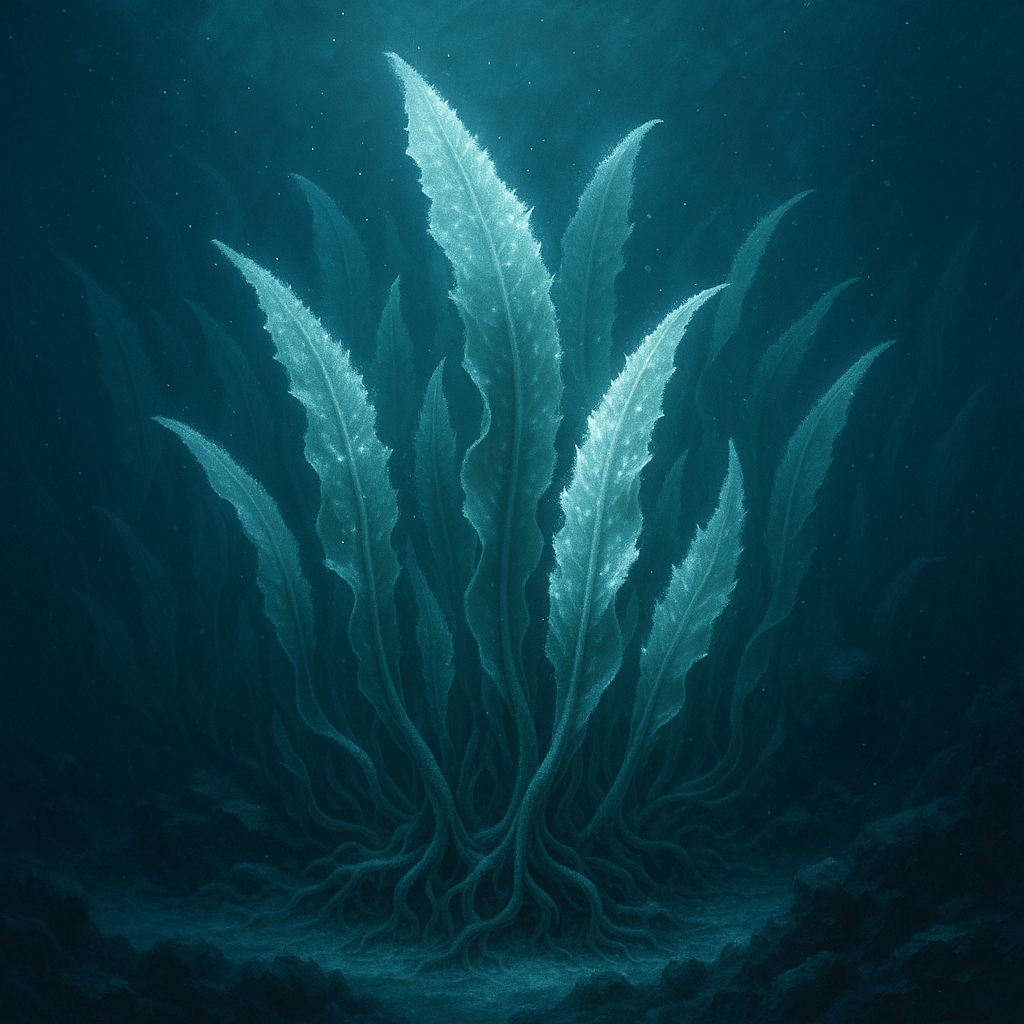Frostbloom Kelp
"Below the ice, the bloom sleeps, soft as silk, cold as winter."
Far beneath Everwealth’s glacial northern coastlines, in waters so cold they silence the heart, sways a forest older than most kingdoms. Frostbloom Kelp is a thick, rubbery plant that rises in dense columns from the ocean floor like pillars of pale jade, each blade shimmering faintly with hoarfrost even beneath the waves. It is said that these kelp beds breathe in unison, rippling in the currents like a sleeping beast. Revered and feared in equal measure, Frostbloom Kelp is among the rarest and most valuable of Everwealth’s marine flora, sought not for food or ornament, but for its unmatched medicinal properties. It is also a death sentence for the unprepared, as the creatures that lurk in its depths, eels, serpents, and things without name, do not take kindly to intruders.
Basic Information
Anatomy
Frostbloom Kelp consists of long, strap-like blades that can reach up to 20 feet in length, with a texture not unlike cured leather. Each blade is rimmed in translucent filaments that hold a natural antifreeze compound, allowing the plant to thrive in freezing depths. When pulled from the water, it releases a burst of vaporous cold, and the blades stiffen quickly, curling like parchment. Its rootlike holdfasts anchor deep into sediment-covered stone, often entangling around sunken wrecks or sea fossils. At the base of each blade are swollen nodules that store a waxy sap, the source of its famed Salves and cold-forged liniments.
Genetics and Reproduction
Frostbloom reproduces via hardy spores released seasonally, typically during the coldest months when water temperatures drop below survivable thresholds for most divers. The spores travel short distances, rarely spreading beyond a few miles of their parent bed, contributing to its rarity. Attempts to cultivate the kelp artificially have failed, as the plant only grows in extreme pressure and cold, conditions not easily replicated outside its abyssal domain.
Growth Rate & Stages
Frostbloom is a slow grower:
- Spores settle over rock or bone and root over the course of a year.
- Juvenile kelp takes 3-5 years to reach usable size.
- Mature stalks, prized by alchemists and physicians, are often over a decade old.
Ecology and Habitats
The kelp thrives only in remote, frigid trenches along the Sea of Teeth and the frozen gulfs north of the Whalebone Isles. These kelp beds form immense submerged groves, likened to underwater cathedrals of green and ice. They are silent, shadowed realms where few predators roam, save for those uniquely adapted to the cold. Frostbloom kelp is most densely clustered around thermal fissures where nutrient-rich waters allow for dense, slow growth. The surrounding ecosystem is hostile: armored jellyfish, translucent eels, and semi-magickal creatures like the Nethertrout are commonly reported near harvest zones.
Dietary Needs and Habits
Frostbloom Kelp absorbs nutrients from mineral-rich waters, often those tainted with volcanic sediment or decayed biological matter. Its antifreeze compound is a byproduct of this unique diet, granting it resistance to freezing solid and making its tissues flexible even at subzero temperatures. The same compound, when extracted, is what gives its salves the ability to reduce swelling, soothe burns, and calm inflammation in joints or hardened skin growths.
Biological Cycle
Perpetually slow, Frostbloom exists in a state of near stasis for most of the year. Only during the winter solstice do the beds emit a strange, pulsing bioluminescence said to call sea creatures to spawn within their folds. This phenomenon, known as the Glowdeep, is feared by divers and sought only by the most desperate harvesters, as it marks the brief period when the kelp’s medicinal sap is at its peak, but also when predators are thickest.
Behaviour
While not sentient, the kelp seems to react to disruptions. Divers report that moving through the beds causes sudden shifts in water current, as though the forest were trying to slow them or drag them deeper. This has led to numerous deaths from tangled limbs, failing heat wards, and broken breathing runes. Still, elite harvest guilds risk the descent regularly, with some claiming that each strand pulled from the deep is worth more than a merchant’s dowry.
Additional Information
Perception and Sensory Capabilities
Frostbloom itself does not perceive, but those who spend long hours near it claim to hear soft, breath-like noises in the water. Some believe this is the kelp itself, others suspect the denizens who hide within, camouflaged in pale greens and blues. Either way, veterans speak of the importance of silence and haste when harvesting. “The Bloom is kind,” they say. “But the roots have ears.”
Scientific Name
Cryophyllum viridis.
Origin/Ancestry
Some scholars trace the kelp’s rise to the early Schism, when fractured magick poisoned shallower waters and drove deepwater flora into new evolutionary paths. Others claim it predates the Fall entirely, a relic of an older world that has always thrived.
Conservation Status
Protected by default due to its environment, Frostbloom cannot be easily overharvested. Nonetheless, unregulated black market harvesters sometimes sell immature blades soaked in ice-mage residue to mimic its true effects, often dangerously diluted or warped. Legal guilds, such as the Coldhook Syndicate or the Alchemists’ Ward, keep tight control over licensed harvests, but rumors of price gouging and sabotage persist. Officially, Frostbloom is classified as a Class III Apothecary Asset, subject to heavy export tax and magical purity checks.



Comments